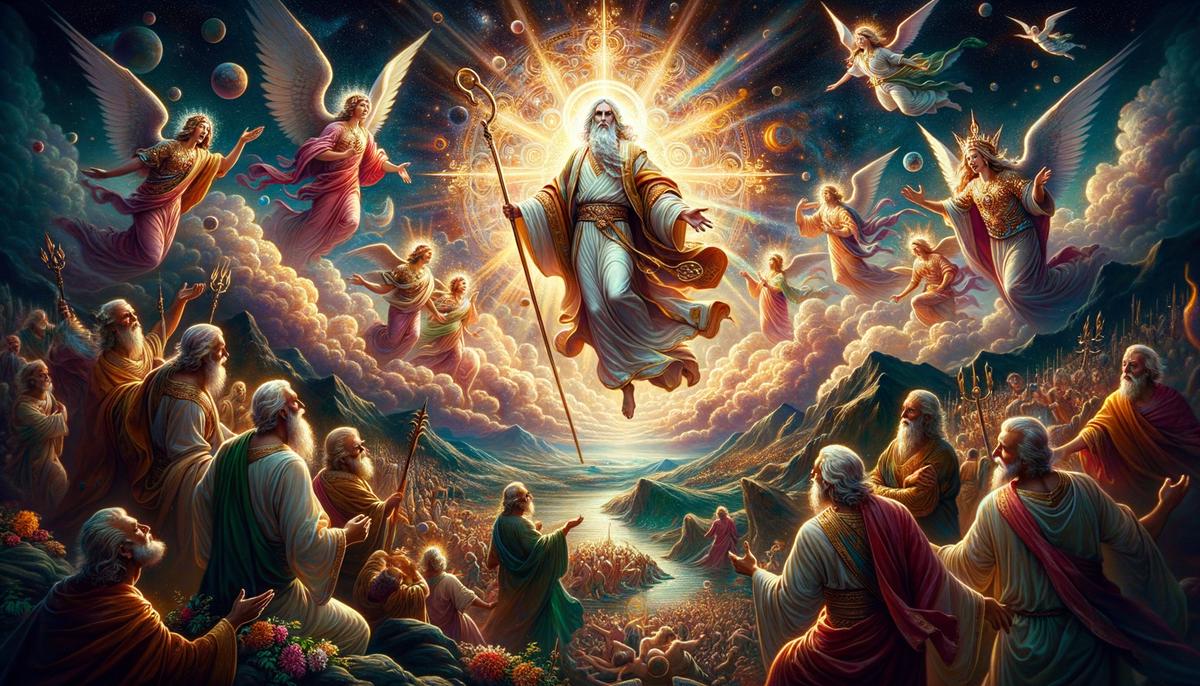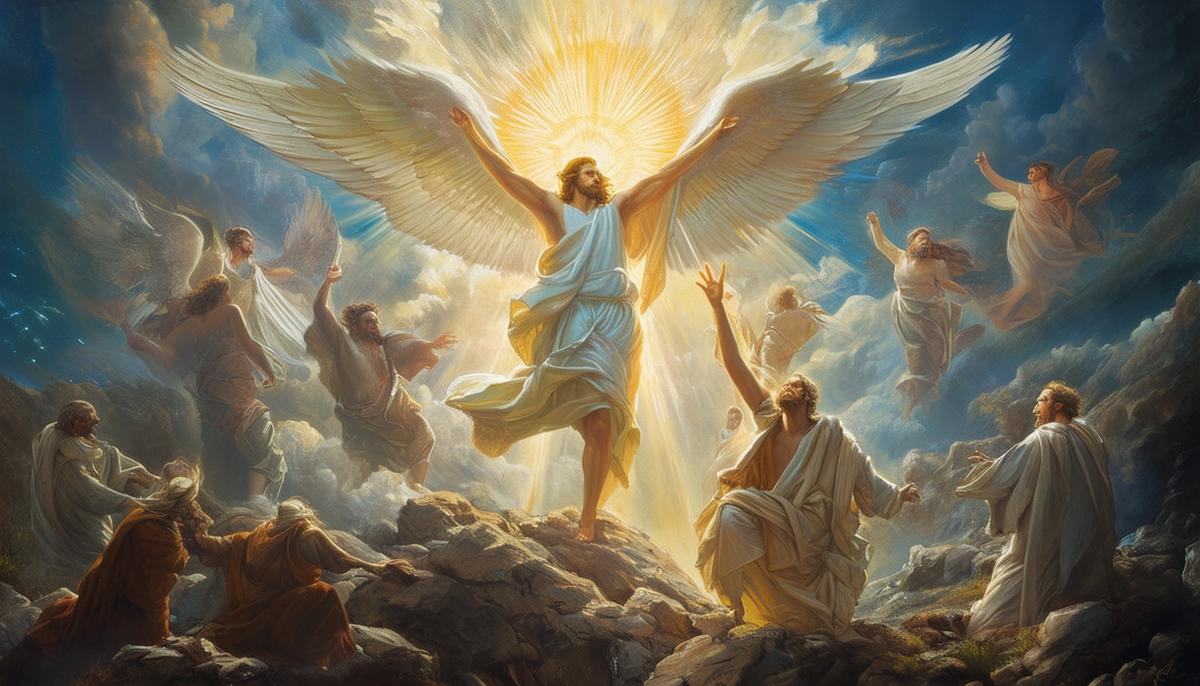Historical Context of Revelation
The Book of Revelation, penned by John the Apostle during his exile on the island of Patmos, serves as a profound narrative rich with apocalyptic visions and symbolic language. This composition, often attributed to the turbulent end of the first century, about 95 AD, emerges during the reign of Emperor Domitian, whose authoritarian rule enforced emperor worship, significantly heightening tensions between the Roman Empire and the burgeoning Christian communities.
Understanding this era is pivotal in grasping Revelation's perennial tone of urgency and perseverance. Christians, under heavy persecution, looked to John's visions for consolation and fortitude. The vivid imagery of beasts and cataclysmic events can be perceived as representations of imperial Rome's oppressive regime, offering both a critique of the current persecutors and a broader metaphysical battle between cosmic forces of good and evil.
John's use of apocalyptic writing was not merely stylistic but a strategic response to these trying times. By coding his messages in symbolism, John could express stark opposition to Roman authorities without direct confrontation. His narrative rallies the Christian community by portraying their struggles as part of a larger divine plan, offering hope that tyranny would eventually succumb to divine justice as foretold in his prophetic visions.
The addresses to the seven churches in Asia Minor encapsulate both commendations and admonitions pertinent to churches grappling with issues such as spiritual complacency, persecution, and doctrinal corruption. These messages underscore the necessity for vigilance and purity within the Christian ranks, pressing the faithful to withstand and overcome the trials of their time.
In essence, the historical context of Revelation paints a picture of a community caught at the crossroads of an empire-wide crisis, escalating religious transformation, and the profound quest for spiritual endurance. Delving into this backdrop enriches our interpretation of the text and anchors the mystical elements of Revelation to the very real experiences of its first-century audience.
Symbolism in Revelation
Symbolism is deeply ingrained in the Book of Revelation, serving to convey John's apocalyptic messages and provide rich layers of meaning that could offer multifaceted interpretations relevant both in antiquity and the present. Deciphering these symbols—the beasts, numbers, colors, and other imagery—unlocks insights into the themes that dominate this profound scripture.
The various beasts that emerge throughout the visions are carefully crafted to represent specific imperial powers, anticlerical sentiments, and spiritual trials afflicting the believers. For instance, the seven-headed dragon represents chaos and ultimate evil, often interpreted as Satan or Rome itself, reinforcing the narrative of a cosmic battle against malevolent forces both spiritual and terrestrial.
Similarly, numbers in Revelation carry deep spiritual significance:
- The number seven, recurring in the contexts of seals, trumpets, and churches, traditionally symbolizes completeness or perfection in biblical terms. This use underscores the notion that the visions impart a complete divine judgment and promise a total fulfillment of prophetic words.
- Another pivotal numerical symbol, the infamous '666', typically associated with the 'beast', is used to denote imperfection and often interpreted as a coded rebuff against specific oppressive Roman emperors, most commonly Nero.
Colors also play a significant role in setting the emotional and thematic tones within Revelation's visions. White, consistently used to depict righteousness (as seen with the white horse or white robes), counters images cloaked in red or scarlet, which connote bloodshed and sin, attributed often to the corrupt and persecutory empire.
These symbolic elements serve as engines driving the major themes of spiritual struggle, divine justice, persecution resilience, and prophetic fulfillment. For the early Christians enduring harsh persecutions, these symbols offered a sense of shared understanding and a covert means of discussing their reality under Roman rule.
Modern readers, though not facing the same socio-political pressures as first-century Christians, can still reflect on their own spiritual battles and societal issues through the symbolic nature of Revelation. This relatability across ages underscores the enduring appeal of Revelation—its symbols transcend their historical origins, prompting each generation to reflect on issues of moral and existential significance through a theological lens.
Understanding Revelation's symbolism offers today's readers a window into early Christian thought and the societal challenges that shaped their religious expressions. This understanding fosters a deeper appreciation of how theology can intertwine with culture and politics in shaping spiritual narratives that strive to transcend the conflicts of any single era.

Interpretative Approaches
The various interpretative views on the Book of Revelation depict the diversity of Biblical interpretation through ages and underline a deep connectivity with eschatological (pertaining to the end times) expectations, which have significantly affected Christian theology. Scholars generally categorize these viewpoints into four main approaches: Preterist, Historicist, Futurist, and Idealist. Each of these perspectives reads the symbols and events in Revelation differently, often leading to scholarly debates and diverse understandings among believers.
- The Preterist view asserts that most, if not all, of the events described in Revelation were meant to happen in the near future of John's audience and indeed did take place in the first century itself. This view takes the urgent calls and warnings of Revelation seriously as it presupposes that the text was addressing imminent events and crises related to the early Church, such as the destruction of Jerusalem or the severe Roman persecutions.
- The Historicist approach reads Revelation as a sweeping overview of the history of the church from the time of John until the second coming of Christ. It suggests that Revelation outlines a long chain of events symbolized by its array of cryptic signs and symbols. Over centuries, subscribers to this view have identified various historical movements and figures in the narrative of Revelation, tying them to significant historical Christian concerns. This approach has waned in popularity in recent days but was quite influential during the Protestant Reformation.
- The Futurist approach, predominate among many contemporary evangelical circles, holds that Revelation primarily deals with events that will occur at the end times. This perspective underlines prophecies awaiting fulfillment, such as the tribulation, the second coming of Christ, the final judgment, and the new Heaven and Earth.
- The Idealist perspective reads Revelation not as a roadmap to specific historical events either past or future, but as a timeless allegory of the cosmic struggle between good and evil. From this angle, Revelation's dramatic narrative symbolizes ongoing spiritual truths applicable to any Christian in any era. It stresses universal themes like God's ultimate victory over evil, the spiritual warfare believers must wrestle with, and the demand for ethical rigor.
Each interpretative approach provides a unique lens through which to view Revelation's storied visions and audacious promises. One's interpretation can impact how one views the nature of God's revelation, the church's role throughout history, moral responsibility, and the supposed sequence of end-time events. The choice of perspective can spiritually shape communities, impact theology, and dictate the urgency and focus of a believer's life and actions. As diverse as these readings are, they underscore the enduring challenge and fascination posed by John's apocalyptic script, inviting each generation to wrestle anew with its rich seams of prophetic proclamations and divine assurance.
Theological Themes
The theological vibrancy of Revelation is characterized particularly by its profound exploration of judgment, redemption, and the sovereignty of the Kingdom of God—themes that resonate deeply within the core of Christian doctrine.
At its heart, Revelation creates a vivid landscape where divine judgment is both a present and future phenomenon. The book unveils a series of judgments unleashed upon the earth—ranging from the breaking of the seven seals to the sounding of trumpets and the pouring out of bowls—all designed to challenge the oppressive forces and justice over wrongdoing. This ongoing pattern reinforces the biblical premise that God is ultimately just and in control of world events, emphasizing the surety of retribution against evil.
Tied intimately to these visions of divine judgment is the promise of redemption—positioned chiefly in the person of Jesus Christ, depicted gloriously as the slain Lamb who has triumphed. Central to the narrative is the recurrent theme of redemption that spans the account of those who have overcome evil by the blood of the Lamb and by their testimony. Herein, John crafts a compelling picture of rescue from persecution and spiritual salvation that seals the faithful's destiny in God's eternal kingdom. This dual motif of redemption via Jesus' sacrificial act and vindication through His final coming underscores the essential Christian belief in Christ as both Savior and Conqueror.
Coupled profoundly with judgment and redemption is Revelation's rich representation of the Kingdom of God. Portrayed as both a present reality and a future promise, the kingdom is depicted as fully coming to fruition with the appearance of the New Jerusalem—a city where God dwells with His people, wiping away every tear, and where death shall be no more.1 Throughout Revelation, the kingdom emerges as the realm wherein God's full authority is expressed and experienced—a place marked by peace, justice, and the absence of suffering, reflecting core aspirations of the Christian faith.
Intricately threaded throughout these thematic currents are calls to endurance and faithfulness amid tribulation, challenges to hold fast against deception and moral compromise, and exhortations to worship God alone. These elements cyclically point back to the doctrines of judgment, redemption, and God's kingdom, framing a circular understanding that God's ultimate plan involves restoring relationships between Himself and mankind, ushering in a new creation free from the scars of sin and rebellion.
Revelation, then, through its vivid imaginal prose and deep symbolic layers, enriches Christian doctrine by drawing together these threads in a tapestry that both warns and comforts. It projects a future hope that rallies believers towards spiritual vigilance and righteousness—ever fixated on the return of Christ and the establishment of His eternal reign.

Revelation's Prophetic Nature
Revelation's vivid portrayals of apocalyptic events and the ultimate return of Christ form the crux of its prophetic nature. John conveys these scenarios through symbolic visions, pointing to an anticipated consummation of history according to God's plan.
Interpreting these prophecies presents unique challenges due to the rich symbolic language that reveals multiple layers of meaning, entwined with metaphysical elements and historical context. Prophecies within Revelation act as a complex mirroring of future predictions, eternal spiritual truths, and past events remodeled in allegorical or symbolic narratives.
Discerning the various signs and sequences, such as the seven seals, trumpets, and bowls, is a central aspect of prophetic interpretation in Revelation. Each series unfolds disasters and divine interventions, which are often interpreted both as future events and ongoing spiritual realities. Successfully unraveling these threads requires balancing historical-critical understanding with theological insights.
The second coming of Christ, depicted as a climax of celestial conflict and a resumption of sovereignty over nations, magnifies the challenge. Scholars assign varied timelines and preconditions to this event based on inter-textual references within the broader biblical canon, opening avenues for eschatological theories.
Methodological interpretation often employs a typological reading, where recurrent themes typify future realities and spiritual undercurrents pertinent to believers in all ages. Such readings emphasize God's ultimate authority over history and morality, focusing on readiness for the Kingdom rather than mapping cosmic schedules.
The study of Revelation's prophetic elements combines historical context, biblical symbology, and theological analysis. The prophetic nature encourages readiness and personal spirituality that aligns with godly virtues amidst adversity, transforming scholarly endeavor into a pastoral mission that equips believers with hope and guidance.

Practical Applications
In today's world, where uncertainty often shadows daily life, the messages and teachings from the Book of Revelation offer actionable considerations for faith, ethics, and maintaining hope amid pressing societal and personal challenges.
Revelation reminds us to maintain our integrity and standards amidst prevailing injustices or moral dilution. Like the exhortations given to the seven churches, individuals and communities today are encouraged to assess and strengthen their commitment to ethical behaviors and spiritual convictions.
The presiding theme of hope in Revelation plays an essential role in motivating positive engagement with the world. For believers enduring various forms of hardship, the vision of ultimate triumph and justice provides sustaining hope. This hope inspires believers to actively partake in initiatives that reflect the principles of the coming Kingdom, striving to mirror the picture of restoration under God's reign.
Absorbing Revelation's teachings encourages reflection on embracing a proactive role in caring for others and stewarding creation faithfully. It prompts the assessment of how our daily decisions align with the biblical invitation to live as citizens of a higher kingdom. This perspective reshapes how we engage with modern societal challenges, advocating for a lifestyle that prioritizes:
- Sustainability
- Charity
- Justice
- Peacemaking
At its core, Revelation's message beckons us toward a lived-out faith that withstands and overcomes trials through reliance on Christ. In coping with current global crises, the text equips us with a theological lens that sees beyond catastrophe, fostering resilience and urging believers to maintain faith in God's sovereign control while exerting influence for godly justice and peace.
Navigating contemporary life with Revelation in hand provides a faith that is actively engaged in manifesting expressions of ultimate victory here and now. The Apocalypse's intricate symphony of prophecy, promise, and exhortation offers light to guide our steps toward embodying gospel-centered lives amidst an often chaotic world.

The Book of Revelation serves as a guide for resilience and hope, emphasizing the importance of steadfast faith in the face of adversity. This central message encourages believers to maintain their spiritual integrity and actively engage in shaping a world that reflects divine justice and truth.


